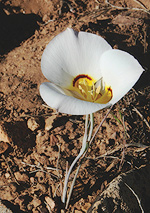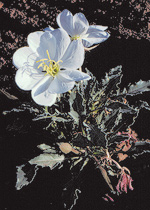Though the parade of wildflowers kicked off in early February here in Canyon Country, the showstoppers are just around the corner.

As the weather warms, the wave of wildflowers in bloom during May reaches a crescendo and can carpet the desert in a kaleidoscope of colors and forms. Numerous flowers unfurl and set out the petal welcome mat to emerging pollinators. The diversity of flower structure and color is amazing and is designed to attract certain types of pollinators that will share their pollination services for rewards of nectar or pollen.
Various plant families are well represented during this springtime flush, while others may have only a few species. Shrubs and cacti also join this parade with blooms that can stop traffic.
Here are some of my favorites.
The sego lily is the state flower of Utah. The edible, onion-like bulbs have been harvested for thousands of years, although nowadays it’s discouraged. With long, strap-shaped leaves and a whitish, three-petaled flower, sego lilies bloom in profusion when conditions are right. Deep inside the cup-shaped bloom, the base of the petals have yellow bases edged in purple which help guide bees and butterflies to nectar glands deep within the flower.
Eaton’s penstemon have long, tubular-shaped red flowers that bloom along an elongated stalk. The colorful flowers attract black-chinned hummingbirds which insert their thin bills and long tongues into the flowers to suck up nectar. The large leaves arranged in an opposite pattern along the stem help to separate this flower from the smaller, related Utah penstemon with flowers that flare open at the tip.
Dwarf evening primrose and pale evening primrose are two related species with white flowers that bloom primarily in the evening. The low-growing dwarf evening primrose is often mistaken for abandoned tissues along the roadside. A patient observer is rewarded with a petalous performance in the early evening hours as the flower’s petals unfurl from the tight cluster and open for the evening. This species attracts white-lined sphinx moths and bees as pollinators. The taller pale evening primrose may bloom in profusion, carpeting the desert with its fragrant flowers.
Another night-blooming plant is the showy four o’clock with its magenta-colored flowers. These sprawling plants grow beneath junipers or pinyons and are a magnificent addition to the floral parade.
Several lupine species also bloom in spring, the bright blue blossoms a magnet for bees and bumblebees which muscle their way into the flowers seeking pollen. A close relative, the silvery sophora, spreads by underground horizontal roots and creates a dense patch of silvery foliage that contrasts to the bluish-purple pea flowers.
Cliffrose is a scraggy shrub that erupts with flowers in late spring. The whitish flowers literally cloak the plant and the sweet aroma that the flowers emit can be detected from far away. Upon closer inspection, the hum of pollinating bees can be heard as they swarm over the flowers.
Another member of the rose family is the Woods’ rose which bears single rose-colored flowers and is armed with small thorns along the stems. Often growing in wetter, streamside locations, these flowers add a splash of color to the verdant vegetation along these riparian corridors.
Often overlooked, perhaps because the small flowers are tucked within the confines of protective, sharp branches, blackbrush is a dominant plant in areas where thin soils cover sandstone basements. These shrubs are an important browse plant for mule deer and bighorn sheep, and when conditions are favorable, large expanses of these shrubs bloom in unison with yellowish flowers.
Though several of the desert cacti, such as Whipple’s fishhook and the claretcup may be nearing the end of their blooming cycle, the prickly pear cactus is a late spring bloomer. Large colorful flowers bloom in various shades of red, magenta, and yellow and attract numerous bees and beetles as pollinators. It’s fun to look within the flowers to see these creatures maneuvering through a forest of stamens as they seek out pollen and nectar.
Enjoy the spectacle of the spring bloom and the creatures these fantastic flowers attract.